The world of RC cars today is characterized by a huge variety of scale, on-road, off-road, electric (EP) and gas powered (GP) machines. However, 30 years ago there was only one class: 1/8 GP cars, which is where the history of RC car racing began. This 1/8 class of GP on-road racing is regarded as the RC racingユs equivalent to Formula Car in the full-scale racing world. Despite the growth in popularity of EP touring cars, 1/8 GP racing remains the sportユs highest performance class in terms of speed and lap times. On a technological level, it also embodies the most advanced design and construction know-how. Kyoshoユs leadership of this class, and for that matter the RC car world, started with the Dash-1 as explained in the first installment of this series. The famous Dash-1 evolved into the Fantom 25 years ago (in 1978). In September 2003, the Fantom continued its heritage with a glorious victory at the 14th IFMAR 1/8 RC Car World Championships held in Ohio U.S.A. To put this victory into perspective, this story will focus on the RC worldユs pioneers, the Fantomユs 25 year history, and the evolution of Kyosho on-road racing machines. First of all, the Japan Model Radio Control Association (JMRCA) was established in February 1971, naturally with the backing of Kyosho, the industry leader. According to JMRCA records, the first organized event was the First Japan-America Goodwill RC Car Race in March 1971. This race was sponsored by the JMRCA and the U.S. Air Force Model Club and held within the grounds of the Tokyo Tachikawa Base. Before 1973, the Vietnam War was still raging and conscription was still in force so there were many U.S. soldiers in Japan with a strong interest in RC. Due to this, the racecars represented the latest technology and the standard of racing was world class. Also, in 1969 the U.S. military moved some assets to a new base in Yokota for strategic reasons, which created even more open space at the vast Tachikawa Base. It should be mentioned that RC racing events were being held within overseas U.S. bases against the backdrop of the serious fighting of the Vietnam War. Within the sprawling U.S. military base, a more than 600 meter long race track was built. Engine performance would make or break a race, and the Kyosho Dash made its first appearance on the international stage with a Super Tiger engine tuned to produce more than 30,000 RPM. Radio systems of the time were susceptible to interference so machines were constantly losing control. The open airfields continued as far as the eye could see, so cars that had lost control just kept going. Normally these cars didnユt run straight anyway, so it was a surprise to see them disappear in an instant. Motorbikes were kept on standby for recovery of these wayward vehicles.  1974 Tachikawa Base: Japan-America Goodwill RC Race. Sponsored by JMRCA and U.S. Air Force Model Club. At about the same time as the race at Tachikawa Base, Kyosho was the main sponsor of a promotional event held in the parking lot at Oiso Long Beach. Reporters from the Yomiuri Shinbun, a leading Japanese daily, covered the event and gave it a national color feature. This triggered RC car fever and encouraged many people to join in. After Tachikawa Base, race circuits in the 70ユs appeared in such places as the Sayama Ski Fields, Oi Race Course Parking Area and Musashino Circuit. Growing popularity saw increased participation of about 200 racers at proper events like the one at Oiso Long Beach. At about the same time, the Japan Radio Control Car Club (JRCC) was organizing grass-track racing for serious RC racers. The JRCC as a subordinate group of the JMRCA and organized about nine races per year. However the contribution of the JRCC to the growth of 1/8 racing cannot be underestimated. At the Oiso Long Beach race, a racer made by Todoroki Model was prominent. Todoroki was a manufacturer of slot racers, and was able to turn many slot racing enthusiasts into RC racing fans. The JMRCA completed its official custom-built race circuit (SPL Speed Way) in September 1978. In November of the same year, Mr. Kiyokatsu Kishi (pictured), drove the Kyosho Fantom 20 to victory in the All-Japan Championship. This spelt the end for Todoroki and established the Fantom as the dominant force in 1/8 class racing in Japan. The 1970ユs was the also the era when Kyosho (Dash ~ Fantom) competed against imported cars. The most competitive imported cars at the time were from Associated (U.S.A.), and PB (UK). Moving into the 1980ユs, the Serpent (Netherlands), and the BMT (Italy), came to prominence. The most competitive amongst these was the Serpent. Kyosho continued to battle against cars from Europe and America using its own racing technology.  1977 Oiso Long Beach JRCC Series (9 races per year). Sets new participation record of 200. The first IFMAR 1/8 RC Car World Championship was held in Los Angeles in July 1977. Subsequent World Championships have been held about every two years since. Team Kyoshoユs first challenge was at the 3rd World Championships held at Indianapolis, U.S.A. Kyosho finished 3rd with Mr. Katsunori Kondoユs Fantom EXP equipped with the RC worldユs first oil pressure shocks on the front wheels. Kyosho also brought a 4WD Fantom that was under development at the time. Other racing teams ridiculed the crazy Japanese for thinking a 4WD car could race on-road. Although oil shocks and 4WD on-road racers are standard today, they werenユt accepted or even understood by the top racing teams from around the world back then. Able to adapt better to any surface, Kyosho was the first to show the world that 4WD cars were effective on-road racers. The 5th IFMAR 1/8 World Championships were held at Tokyo Disneyland in July 1985. Kyosho finished 2nd and 10th with the Fantom 4WD 3P, but was still chasing Serpent and Associated. After that, Kyosho temporarily stopped production of the Fantom and suspended its involvement in the 1/8 GP on-road racing class. 1/8 scale also ceased to be the main focus of RC car manufacturers. For 10 years from 1989 to 1999, Kyosho imported and sold BMT and Picco cars from Italy to fill what demand was there.  1978 July GC Competition. Race circuit is Fuji Speedwayユs B-paddock. The Kyosho Fantom made its comeback to the 1/8 racing scene in 2000. While the market for RC cars was dominated by other categories, 1/8 on-road racing still remained the RC worldユs highest speed and performance class. The current President of Kyosho, Mr. Akihisa Suzuki, was determined to put a plan in place to re-take the lead in this category. Although Kyosho was at the forefront of growth in the popular 1/10 GP touring cars, Kyoshoユs race heritage started when it built its first Japanese made car 33 years ago and continued with its critical role in the development of the world of RC cars. In this context, itユs easy to understand why conquering the RC racing worldユs top category was more than just a project; it was a duty. That this mission was achieved in its 3rd year makes it all the remarkable. Some readers may think that after 30 years, Kyosho has finally beaten Serpent, but this is not the reality. Kyosho has always been a technological leader in innovation in RC car design just as it was when it brought 4WD and oil shocks to the on-road racing world. |
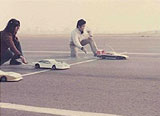
1974 Tachikawa Base: Japan-America Goodwill RC Race. Sponsored by JMRCA and U.S. Air Force Model Club. 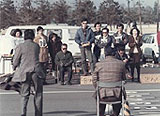
1973 Musashino Circuit finish line. Still hand made racing at this stage. 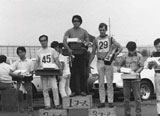
Same Musashino Circuitユs presentation stage. Podium was apple crate. 3rd place was U.S. soldier. 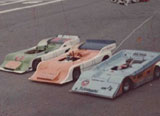
Perennial winning machine of the time: (two cars on right) Kyosho Dash 2 Climax Porsche 930 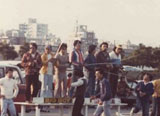
1974 Oi Race Course Parking Area. Race sponsored by JRCC. Spectator crowds were gradually growing. 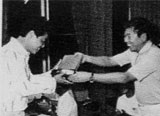
Presentation ceremony at same race. Mr. Hisashi Suzuki (JMRCA Chairman and Kyosho founder) presents winnerユs trophy to Mr. Hiroshi Shudo. Mr. Suzuki fostered the RC car racing world in Japan. 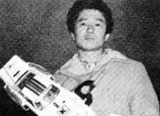
1977 1/12 electric car race. The first EP car race. Winner Mr. Kiyokatsu Kishi with his Kyosho Porsche 935. Radio used was Futaba 2 channel. Telecast on NTVユs メBikkuri Nihon Shinkirokuモ program and created RC fans across Japan. Transition to Kyosho On-Road Models 1/8 GP Racers 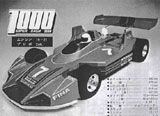
The Super Dash 1000: successor to the Dash 3 (mentioned in Kyosho RC Car History Part 1). Body is a Brabham BT-45. Also available were Lola T292, Ferrari 312-1P and Porsche 917-30. 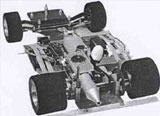
The Super Dash 1000 chassis produced in 1977. Rear axle is equipped with drum brake. 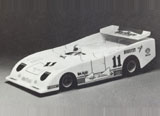
1979 ミ the Power Dash is released for beginner racers. Uses a strong white ABS body able to sustain severe shocks. Picture shows Alfa Romeo T-33SC12 Turbo. Also available were the DeTomaso Panterra GR5, and the Mooncraft Chevron B-23. 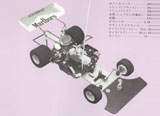
1979 Fantom 20. The first 1/8 car in the Fantom series. Featured front/rear split chassis, aluminum block front cross members, and stainless steel knuckle arms for extra strength. The first to be equipped with a disk brake. 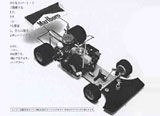
1985 Fantom 20. Two-piece Duralumin chassis. Optimum use of downforce was an objective. 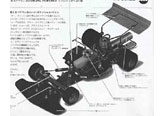
1985 Fantom Expert chassis. Dedicated racing machine. Use of glass fiber and Duralumin required a two-piece chassis. Oil pressure shocks mounted on the front revolutionized RC cars. |
|
1/8 GP Racers
1/12 GP Racer
1/20 EP Racer
1/12 EP Racers
1/10 EP Racer
Thank you to the following people for their cooperation during research for this story.
|